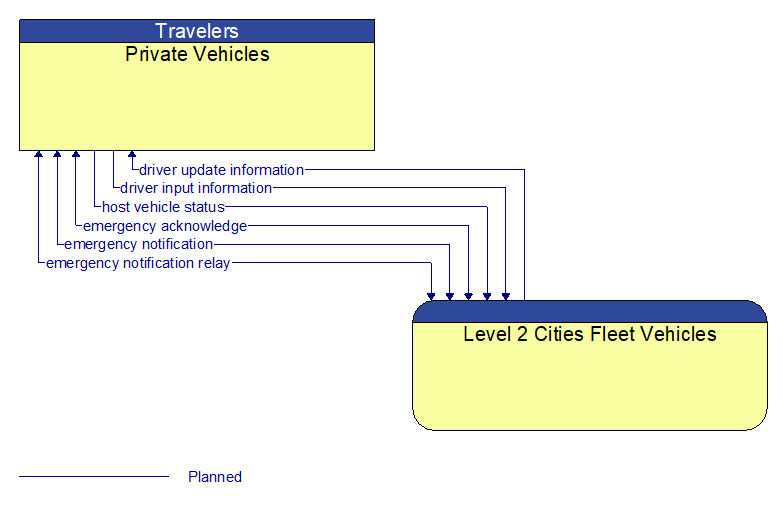Interface: Private Vehicles - Level 2 Cities Fleet Vehicles

Information Flow Definitions
driver input information (Planned)
Driver input received from the driver–vehicle interface equipment via the vehicle bus. It includes configuration data, settings and preferences, interactive requests, and control commands for the connected vehicle on–board equipment.
driver update information (Planned)
Information provided to the driver–vehicle interface to inform the driver about current conditions, potential hazards, and the current status of vehicle on–board equipment. The flow includes the information to be presented to the driver and associated metadata that supports processing, prioritization, and presentation by the DVI as visual displays, audible information and warnings, and/or haptic feedback.
emergency acknowledge (Planned)
Acknowledge request for emergency assistance and provide additional details regarding actions and verification requirements.
emergency notification (Planned)
An emergency request for assistance that is automatically initiated by a vehicle or manually initiated by a vehicle occupant. The request includes call–back number, date, time, location, pre–event vehicle heading, vehicle make, model, model year, and fuel type, and crash severity indicators. Crash severity indicators include: airbags deployed, number of impacts, crash delta velocity, principle direction of force, and rollover indication. In addition, seatbelt restraint use, number of occupants, occupant location, and intrusion may be included. For commercial vehicles, this flow may also include freight equipment type (box, flatbed, trailer, container, etc.), type of cargo (refrigerated, non–perishable, liquid, etc.), hazardous material data, quantity of cargo, and cargo permits as applicable (hazmat, special routing permissions).
emergency notification relay (Planned)
The relay of a previously received emergency notification. This relay enables a connected vehicle that is passing within radio range of a vehicle in need of assistance to store the notification and then forward it to a public safety agency when communications is available. Multiple relays may be necessary in remote areas with infrequent traffic and spotty communications coverage. The relay includes all of the information included in the original emergency notification (see 'emergency notification') and relay–specific data that can be used to manage the relay. Relay–specific data may include the date and time of original emergency notification receipt and the number of times the message has been relayed.
host vehicle status (Planned)
Information provided to the ITS on–board equipment from other systems on the vehicle platform. This includes the current status of the powertrain, steering, and braking systems, and status of other safety and convenience systems. In implementations where GPS is not integrated into the Vehicle On–Board Equipment, the host vehicle is also the source for data describing the vehicle's location in three dimensions (latitude, longitude, elevation) and accurate time that can be used for time synchronization across the ITS environment.